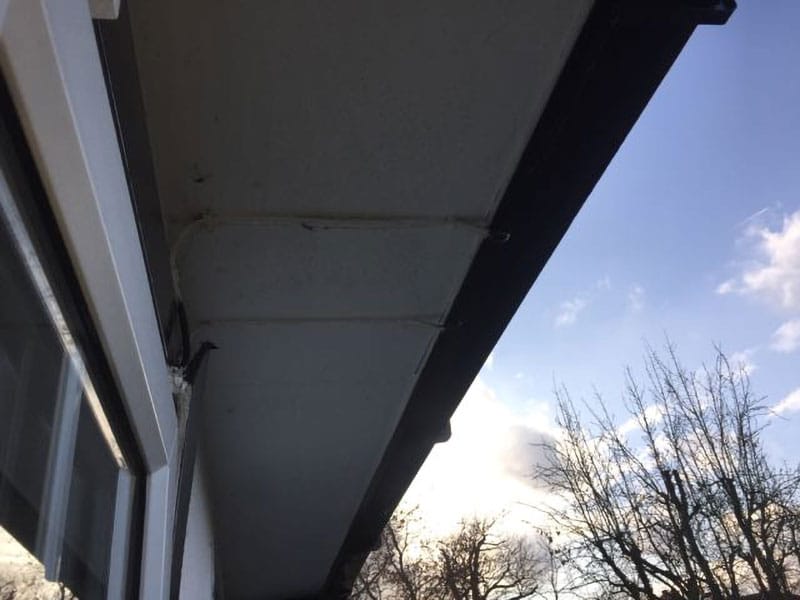Can I cover asbestos soffits with PVC boards (or should they be removed)?
During its peak period of use from around the 1950s until the 1980s, asbestos was incorporated into all manner of places in UK residential, commercial, and public buildings.
Once known as a “wonder material”, but eventually banned in the UK in 1999 as the dangers it posed to health became more widely known, asbestos was also sometimes incorporated into soffits – the horizontal boards installed underneath roof fascia’s.
It isn’t known exactly how many asbestos-containing soffits might exist at properties around the UK. However, asbestos has been estimated to be present across as many as 1.5 million buildings up and down the country. So, if you know your property’s soffits date to before the year 2000, you should be vigilant about the potential for them to contain asbestos.
If you do know – or at least suspect – that your building’s soffits contain this now-banned mineral, you may be wondering whether to cover the soffits or instead have them removed.
In this article, we will seek to provide clear and actionable advice to help you decide.

What are asbestos soffits, and how do their types influence decisions on removal or covering?
The underfitted boards on a roof structure known as soffits should not be confused with fascia’s, which – unlike horizontal soffits – are the vertical boards at a roof’s edge.
By contrast, soffits cover the underside of a roof overhang. They’re key for protecting the roof rafters from the ravages of the outdoor conditions, including the weather, insects, and pests.
However, during the period from the 1970s until the 1990s, it was common for soffits to have asbestos incorporated into them.
There were two main types of asbestos material used to produce soffits. This is important to be aware of, because it can have implications for the risks that asbestos soffits may pose:
- Asbestos insulating board, or AIB This is considered the higher-risk form of asbestos-containing material (ACM), of the two mentioned here. Historically, it consisted of around 20% to 45% asbestos. It is also the softer of the two, and more porous or “friable” (this referring to the tendency for a material to crumble when physical pressure is exerted on it).
- Asbestos cement
Asbestos cement differs greatly from AIB in its material makeup. The proportion of asbestos cement in this material is about half what is seen in AIB, and it is heavily bonded and non-friable. This means that even in the event of an asbestos cement soffit being disturbed or broken, there should be only minimal asbestos fibre release.
It is important to emphasise, however, that even an asbestos cement soffit in good condition cannot be regarded as “harmless”, including when it comes to any potential removal work.
This underscores the importance of arranging for professional testing in order to identify the type of asbestos material that may have been used to produce your property’s soffits.
When is it appropriate to cover asbestos soffits with PVC boards instead of removing them?
The broadly accepted principle as far as covering asbestos soffits with PVC boards is concerned, is that while it is sometimes done, it is often not the best approach.
The idea behind using PVC boards to cover a property’s asbestos soffits is that it can encase the asbestos. This, at least theoretically, can protect the material from being disturbed – and therefore guard against the risk of dangerous asbestos fibres being released – in the future.
Covering asbestos soffits with PVC boards can also present certain other advantages. It may be cheaper upfront than having the soffits removed, and it can be more convenient and less disruptive an operation than removal.
But on the other hand, the process of nailing or screwing asbestos soffits in order to secure the PVC boards disturbs the material, thereby releasing asbestos fibres. Such overcladding also leaves the asbestos in place, which may complicate future repairs or inspections.
In summary: covering your asbestos soffits with PVC boards could be an option if the soffits are asbestos cement (not AIB) and in pristine condition, and the PVC can be fixed without the asbestos being pierced.
Even in such favourable circumstances, it can still be a gamble, and experts generally advise against it. This is not least because the asbestos will remain in place, potentially bringing long-term dangers as it deteriorates over time.
What installation methods are safe when covering asbestos soffits with PVC boards?
As we mentioned above, if you do decide to go ahead with PVC overcladding of your building’s asbestos soffits, standard installation methods – such as screwing and nailing – can cause the potentially dangerous release of asbestos fibres.
So, for this reason, it is important to look into the non-invasive installation methods that could be used. This could entail the use of specialised bracket systems, or a flexible adhesive that allows for expansion and contraction without the underlying asbestos sustaining damage.
With the PVC boards in place over the soffits, you might also opt to seal the seams between the boards with caulk or another sealant. This can guard against the risk of moisture seeping through to the underlying asbestos soffits.
What does the complete asbestos soffit removal process involve?
If you decide to have your asbestos soffits removed rather than covered or encapsulated, it will be crucial to determine whether the removal work will need to be undertaken by a professional holding a licence from the UK Health and Safety Executive (HSE).
Again, the specific type of asbestos material involved will come into play here:
- If the soffits are made from asbestos insulating board or AIB, the contractor removing them is likely to need to hold a full HSE asbestos licence. They will also need to notify HSE of the removal works two weeks before they start.
- If the soffits are made from asbestos cement, a licence is not typically required by the person carrying out the removal. Nonetheless, given that asbestos cement soffits are still potentially dangerous, we would urge you to arrange for a licensed contractor to carry out any removal work, instead of attempting to do it yourself.
When the time comes for the removal work to be undertaken, the process will typically be as follows:
- A comprehensive risk assessment is carried out. The contractor will identify the type and condition of the asbestos soffits, and they will decide on suitable removal methods.
- Site preparation takes place. This stage will include the work area being cleared of obstructions. The soffits will also be dampened with water and suppressant to minimise the release of asbestos fibres during the removal operation.
- A containment area is established around the work site. An asbestos enclosure will be constructed, and it may be under negative pressure to help further minimise any spread of asbestos fibres.
- The asbestos soffits are carefully removed. Wearing suitable personal protective equipment (PPE), the contractor will use hand tools, such as screwdrivers or pry bars, instead of power tools, given that the latter could generate dust.
- The space is decontaminated. A HEPA vacuum will be used to clean surfaces and capture asbestos fibres, along with wet wiping to further clean surfaces and equipment.
- Air testing is carried out. This will be aimed at making sure no asbestos fibres are lingering in the atmosphere after the removal process.
- The asbestos waste is disposed of. This will involve it first being carefully handled and placed into sealed and labelled bags. The asbestos waste will then be transported to an authorised site for disposal.
- Post-removal procedures are undertaken. The area – including the enclosure and tools – will be thoroughly cleaned, and a visual inspection will be conducted. A final air test will then be carried out to confirm it is safe to reoccupy the given area.
How do costs compare between covering asbestos soffits with PVC boards and removing them?
We have previously put together an extensive guide to how much you can expect to pay to have asbestos soffits removed.
The covering of asbestos soffits with PVC boards may be significantly cheaper than having such asbestos materials removed. However, the exact costs will depend on such aspects as the type of asbestos material involved, and the accessibility of the soffits.
Is encapsulation a viable alternative to removal or covering, and how does it differ?
The encapsulation of asbestos soffits differs from covering asbestos soffits with PVC boards. The former of those two processes involves applying a protective coating to the ACM to “seal it off”.
Indeed, encapsulation might be a preferrable option to covering in cases where the asbestos soffits are in good condition and are not being disturbed. If, on the other hand, the asbestos soffits are damaged or deteriorating, covering them with PVC boards might make greater sense.
Conclusion: seek out professional help to ensure you take the most suitable steps
Hopefully, this article will have helped give you a sense of the merits that covering, encapsulating, or removing asbestos soffits can all have as possible courses of action.
By arranging for the professional assessment at any materials at your property that you suspect to be asbestos, you can equip yourself with the information that will enable you to make the best possible choice about the ACMs that may be present.
In the case of asbestos soffits – as with other ACMs – it will be of the utmost importance to prioritise the highest standards of safety, compliance, and long-term building management.
To receive advice, guidance, and a free quote for any of our asbestos services at Oracle Solutions, please don’t hesitate to get in touch with our team today.

Written by Callum McDonald
Callum McDonald is an expert in asbestos quality management, ensuring rigorous adherence to regulations and high-quality standards in removal projects. His focus on enhancing quality and client satisfaction makes him a crucial asset in safety and compliance within the field. Callum's expertise in technical support and oversight of licensed works underscores his commitment to excellence in asbestos management, providing invaluable guidance to clients in this specialised area.
